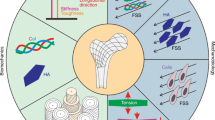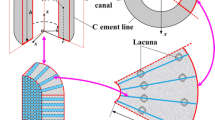Summary
The behavior of the fluid in stressed bone is examined in order to determine what stimuli cells in bone would experience when bone is stressed. It is found that the fluid pressure in the vascular channels should have a very short relaxation time, on the order of millisecondsin vivo. The case for the lacunar-canalicular systems is more difficult to analyze, but the fluid pressure in these pore systems may not relax as rapidly. The experimental evidence concerning fluid flow is difficult to interpret because of the complicated porosity in bone and the dependence of the permeability on sample preparation techniques. Nevertheless, the data are consistent with a fast relaxation time for the vascular channelsin vitro, which means that the long relaxation time observed in the electromechanical effect is due either to the flow in the lacunar-canalicular systems or to the flow in the microporosity.
Similar content being viewed by others
References
Jendrucko RJ, Hyman WA, Newell PH, Chakraborty BK (1976) Theoretical evidence for the generation of high pressure in bone cells. J Biomech 9:87–91
Rodan BA, Bourrett LA, Harvey A (1975) Cyclic AMP and cyclic GMP: mediators of the mechanical effects on bone remodeling. Science 189:467–469
Piekarski K (1981) Mechanically enhanced perfusion of bone. Mechanical properties of bone. Joint ASME-ASCE Appl. Mech. Conf. AMD Vol 45:185–191
Bassett CAL (1971) Biophysical principles affecting bone structure. In: Bourne GH (ed) The biochemistry and physiology of bone, Vol. III. Academic Press, New York. pp 1–76
Gross D, Williams WS (1982) Streaming potentials and the electromechanical response of physiologically-moist bone. J Biomech 15:277
Starkebaum W, Pollack SR, Korostoff E (1979) Microelectrode studies of stress-generated potentials in four-point bending of bone. J Biomed Mat Res 13:729–751
Biot MA (1941) General theory of three-dimensional consolidation. J Appl Physics 12:155–164
Biot MA (1955) Theory of elasticity and consolidation for a porous anistropic solid. J Appl Physics 26:182–185
Johnson MW, Chakkalakal DA, Harper RA, Katz JL, Rouhana SW (1982) Fluid flow in bone in vitro. J Biomech 15:881–885
Hughes S, Davies RD, Khan R, Kelley PJ (1978) Fluid space in bone. Clin Orthop 134:332–341
Frost HM (1962) Specific surface and specific volume of normal human lamellar bone. Henry Ford Hosp Med Bull 10
Rouhana SW, Johnson MW, Chakkalakal DA, Harper RA, Katz JL (1981) Permeability of compact bone. Joint ASME-ASCE conference Biomechanics Symposium, AMD Vol 43:169–172
Rouhana SW (1983) Fluid flow and mechanical damping in bovine cortical bone. PhD Thesis, Rensselaer Polytechnic Institute
Prothero JW, Burton AC (1962) The physics of blood flow in capillaries: II. The capillary resistance to flow. Biophysical J 2:199–212
Anderson JC, Eriksson C (1970) Piezoelectric properties of dry and wet bone. Nature 227:491–492
Nowinski JL (1972) Stress concentration around a cylindrical cavity in a bone treated as a poroelastic body. Acta Mechanica 13:281–292
Simon SR, Paul IL, Mansour J, Munro M, Abernethy PJ, Radin EL (1981) Peak dynamic force in human gait. J Biomech 14:817–822
Author information
Authors and Affiliations
Additional information
This work was supported in part by PHS Grant 1 R01 AM31894.
Rights and permissions
About this article
Cite this article
Johnson, M.W. Behavior of fluid in stressed bone and cellular stimulation. Calcif Tissue Int 36 (Suppl 1), S72–S76 (1984). https://doi.org/10.1007/BF02406137
Issue Date:
DOI: https://doi.org/10.1007/BF02406137




